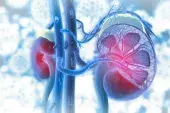Updated guidelines for managing diabetes in patients with chronic kidney disease
By Rebecca Jenkins
Clinicians should layer care for patients with diabetic chronic kidney disease (CKD), starting with lifestyle measures and first-line pharmacotherapy, updated international guidelines advise.
The Kidney Disease: Improving Global Outcomes (KDIGO) 2022 Clinical Practice Guideline for Diabetes Management in Chronic Kidney Disease includes 13 recommendations and 52 practice points for clinicians caring for this patient group.
In a synopsis published in the Annals of Internal Medicine, the guidelines working group recommended a foundation of lifestyle interventions, self-management and first-line pharmacotherapy, such as sodium-glucose cotransporter-2 (SGLT-2) inhibitors.
‘Specifically, SGLT2 inhibitors are the preferred first-line pharmacologic therapy for patients with [type 2 diabetes] and CKD, regardless of glycemic control, with other glucose-lowering therapies added to the SGLT2 inhibitors to maintain individualized glycemic targets,’ the working group wrote.
Glucagon-like peptide-1 receptor agonists (GLP-1 RAs) continued to be recommended as a second-line drug class for glucose lowering in patients with type 2 diabetes and CKD, with a new practice point highlighting the potential for weight loss with the therapy.
A newly added section on nonsteroidal mineralocorticoid receptor agonists (MRAs) suggested use of a nonsteroidal MRA with proven kidney or cardiovascular benefit for patients with type 2 diabetes, an estimated glomerular filtration rate (eGFR) of at least 25 mL/min/1.73 m2, normal serum potassium concentration, and albuminuria despite maximum tolerated dose of a renin-angiotensin system inhibitor.
Coauthor Professor Jonathan Craig, Vice President and Executive Dean of the College of Medicine and Public Health at Flinders University, Adelaide, said the guidelines included a change to the eGFR threshold for SGLT-2 inhibitors from at least 30 to at least 20 mL/min/1.73 m2.
‘This is really a small change in the lower GFR threshold, from 30 to 20 based upon increased evidence (more trials and subgroups of trials) of the benefit of SGLT-2 use in this patient group,’ he said.
Almost all the drugs recommended in the guideline are available via the PBS for patients with diabetes and/or chronic kidney disease, except the nonsteroidal MRAs.
Coauthor Professor Hiddo Lambers Heerspink, Co-Director of the Better Treatments Program at The George Institute for Global Health and a visiting professor at UNSW Sydney, said newer therapies including SGLT-2 inhibitors and the nonsteroidal MRA finerenone, the only drug in this class to meet the KDIGO criteria, should be routinely considered in patients with diabetic kidney disease to slow disease progression.
‘However, lifestyle therapy remains the foundation for the treatment of diabetic kidney disease, and we have to continue to stress the importance of physical activity, nutrition and approaches to weight loss,’ he told Medicine Today.
Ann Intern Med 2022; doi: 10.7326/M22-2904.


